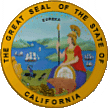| |
Gubernatorial
Candidate | Political
Party | Popular Vote |
 | Peter H. Burnett | Nonpartisan |
6,783 |
47.72% |
 | Winfield Scott Sherwood | Nonpartisan |
3,220 |
22.66% |
 | John A. Sutter | Nonpartisan |
2,201 |
15.49% |
 | John W. Geary | Nonpartisan |
1,358 |
9.55% |
 | William M. Stewart | Nonpartisan |
619 |
4.36% |
 | Scattering | - |
32 |
0.23% |
 |
Map Key
| > 40% |
 |
 |  |
| > 50% |
 |
 |  |
| > 60% |
 |
 |  |
| > 70% |
 |
 |  |
| > 80% |
 |
 |  |
| > 90% |
 |
 |  |
| Turnout
 |  |
|
|
| Election Notes:
- For this election, California was divided into 10 election districts; no counties had been established yet, although each district's name covers an area that includes each one's modern county. The District of San Jose covered generally what is now Alameda, Contra Costa, and Santa Clara counties. The "state" (see below) legislature's canvass gave the totals as 6,710 for Burnett, 3,188 for Sherwood, 2,201 for Sutter, 1,475 for Geary, and 619 for Stewart. The Journal of the Senate only lists figures by election district for Burnett and Sherwood.
- The United States acquired Alta California from Mexico on May 30, 1848 under the terms of the Treaty of Guadalupe Hidalgo. The discovery of gold by James Marshall at Sutter's Mill (the same Sutter running for governor) on January 24, 1848 triggered the California Gold Rush and resulted in meteoric population growth for the new territory of California. On June 3, 1849, the military governor of California, Bennett C. Riley, called for a constitutional convention to take place in Monterey with the expectation that California would soon become a state.
Under the new constitution, California held its first general election on November 11, 1849. Simultaneously, the expansion of slavery in the newly acquired territories was a hot-button issue back east. The Monterey Constitution banned slavery in the entire territory, including in the land south of the line delineated by the Missouri Compromise of 1820.
While Congress debated the California and slavery issues, Bennett Riley ceded his powers to Peter Burnett on December 20, 1849. Although California was not yet a state, it functioned as a de facto state from that point forward, including electing its would-be United States Senators: John C Fremont, who was anti-slavery, and William Gwin, who was pro-slavery. Back in Washington, Henry Clay proposed a series of resolutions to end the debate in January of 1850 and these were hashed out over the course of the next eight months.
Congress finally passed the California Admission Act on September 9, 1850 as part of the Compromise of 1850, which simultaneously admitted California as a free state, strengthened fugitive slave laws (the Fugitive Slave Act of 1850), defined the borders of Texas, and established the Territory of Utah (which included the northern part of Alta California not included in the new State of California) and the Territory of New Mexico (which included the southern part of Alta California outside the new state and much of western Texas). The status of slavery in both new territories was not addressed at this time. The remaining modern territory of the Southwestern United States was acquired from Mexico in the Gadsden Purchase of 1854.
- Peter Burnett proved to be highly unpopular with both the public and the state legislature. Unable to advance his agenda, he resigned on January 9, 1851. Burnett was succeed by Lieutenant Governor John McDougal, who served the remainder of the term.
| Election Data and Statistics:
- County Data (Table) (m)
- County Data (Graphs) (m)
|
| | Election Tools
- Atlas Forum Image Code for Maps: County
Data Sources:
- Source for Popular Vote data: California State Archives, "Governor," Aggregate of Votes for Governor, Lt. Governor and Members of Congress (Monterey, 1849)
| Results for and Individual County:
|
|
| |